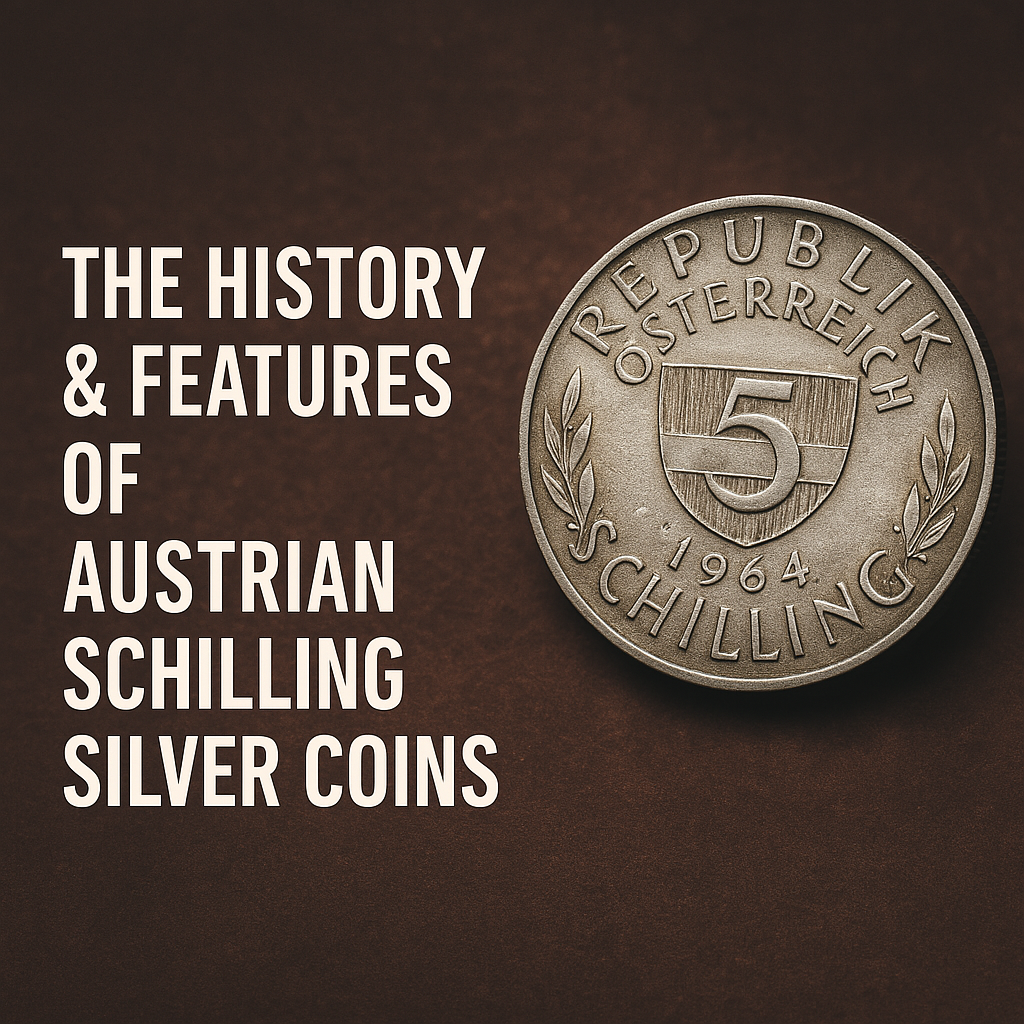The Austrian Schilling Silver Coin: A Journey Through History, Craftsmanship, and Cultural Identity

Once the heart of Austria's monetary system, the Austrian Schilling silver coin now stands as a treasured symbol of the nation’s rich history, economic resilience, and cultural pride. From its origins in the wake of World War I to its replacement by the euro in 2002, the Schilling reflects Austria’s complex past and evolving identity. Today, Schilling silver coins are prized collector’s items, admired for their artistry and historical significance.
Historical Context of the Austrian Schilling
First Schilling Era (1924–1938)
The Austrian Schilling was introduced on March 1, 1925, following the collapse of the Austro-Hungarian Empire after World War I. It replaced the kronen at an exchange rate of 1 Schilling = 10,000 kronen, stabilizing the national economy amid postwar turmoil.
During this period, Austria produced beautifully crafted silver coins, including 50 groschen and 1 Schilling coins in 1925, and a 5 groschen nickel coin in 1931. In 1934, silver 50 groschen and 1 Schilling coins were replaced with nickel versions, while a new 5 Schilling silver coin was introduced.
This era ended in 1938, when Austria was annexed by Nazi Germany (the Anschluss). At that point, the currency was exchanged at a rate of 1 Reichsmark = 1.5 Schillings.
Second Schilling Era (1945–2002)
Following WWII, the Schilling was reintroduced by the Allied forces in November 1945. Currency reform allowed citizens to exchange Reichsmarks for new Allied-issued Schilling banknotes.
A new monetary law in 1947 brought further reforms. Banknotes exceeding 150 Schillings were exchanged at a 1:3 ratio, while coins remained unaffected. The economy stabilized, and by the 1950s, the Schilling was fixed to the US dollar at 1 USD = 26 Schillings.
Austria eventually adopted the euro in 1999 (legally) and fully transitioned to euro coins and banknotes by 2002, marking the end of the Schilling era.
Types and Characteristics of Austrian Schilling Silver Coins
The 5 Schilling Silver Coin
Among Austrian silver coins, the 5 Schilling holds a special place, especially the version minted in the 1960s:
-
Diameter: 23.5 mm
-
Weight: 5.2 g
-
Composition: 64% silver, 36% copper
-
Minted: 1960–1968 (as silver coins)
What makes this coin particularly noteworthy is its reverse trajectory in metal composition. Originally made of aluminum, the 5 Schilling coin was upgraded to silver—a rare move, as most currencies switch from precious to base metals during economic downturns. This change reflected Austria’s post-war economic growth.
After 1969, the coin reverted to cupronickel (75% copper, 25% nickel), with a slightly lighter weight of 4.8g.
Iconic Design Elements
The 5 Schilling silver coin showcases Austrian national pride:
-
Obverse: Features the Austrian coat of arms, the inscription 'REPUBLIK ÖSTERREICH', and olive branches.
-
Reverse: Displays the denomination 'SCHILLING 5', the mint year, and a white Lipizzaner horse with a flag bearer, representing Vienna’s famed Spanish Riding School—one of the oldest classical equestrian institutions in the world.
This elegant design embodies Austria’s cultural heritage and refined artistic tradition.
Commemorative Silver Coins
In addition to circulating coins, Austria issued several commemorative silver Schillings honoring national figures and milestones:
-
1928: 2 Schilling – Franz Schubert (100th death anniversary)
-
1929: 2 Schilling – Theodor Billroth
-
1930: 2 Schilling – Walther von der Vogelweide
-
1934–1937: Coins honoring Engelbert Dollfuss, Prince Eugene of Savoy, and Karlskirche
-
1935: 5 Schilling – Magna Mater
These coins commemorate cultural icons, making them highly collectible among historians and numismatists alike.
Collectibility and Market Value
Modern Exchange and Collector Demand
Although the Schilling is no longer in circulation, Austrian National Bank branches still accept Schilling coins and notes for euro conversion—a rare policy among European nations. The fixed exchange rate is 1 euro = 13.7603 Schillings.
However, many silver coins now trade well above their face value, especially in pristine condition. For instance, a 1964 5 Schilling silver coin may fetch around ¥1,700 (approx. €12) on auction sites—nearly 30× its actual exchange value.
Tips for Collectors
When collecting Austrian Schilling silver coins, consider the following:
-
Check Mint Year and Material: Metal composition varies by year (aluminum, silver, cupronickel).
-
Condition Matters: Uncirculated or proof coins are worth significantly more.
-
Verify Authenticity: Buy from reputable dealers to avoid counterfeits.
-
Learn the History: Understanding the historical context enhances appreciation and investment potential.
The Austrian Schilling silver coin is more than just a piece of currency—it’s a mirror of Austria’s national identity, craftsmanship, and economic evolution. From its unique transition from aluminum to silver in the post-war boom to its commemorative tributes to cultural icons, the Schilling holds enduring value for collectors.
Even 20+ years after Austria transitioned to the euro, Schilling coins remain highly prized by enthusiasts worldwide. Backed by a robust redemption policy and minted by the historic Vienna Mint, these coins continue to tell the story of a resilient and culturally rich nation.
Whether you're a seasoned collector or just beginning your numismatic journey, Austrian Schilling silver coins offer a fascinating and rewarding connection to Europe’s economic and artistic legacy.
Would you like a custom thumbnail image or social post to go with this article?
